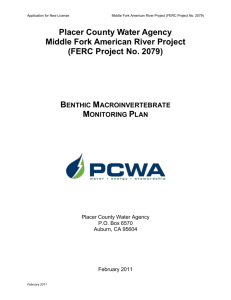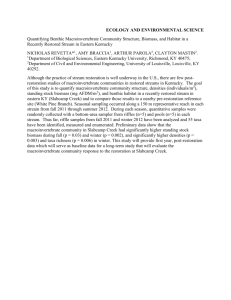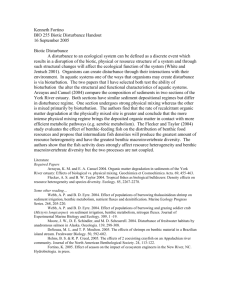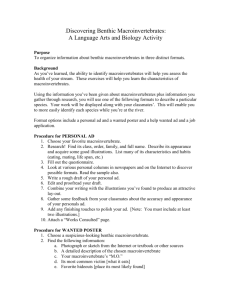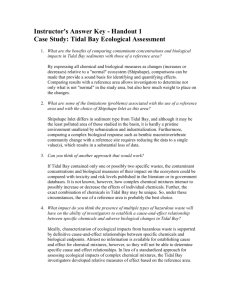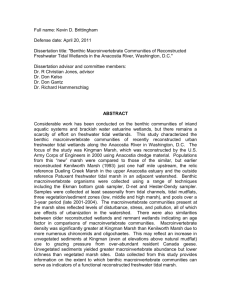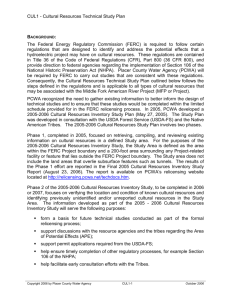02_BMIMPText_Clean_121211 - Middle Fork American River
advertisement
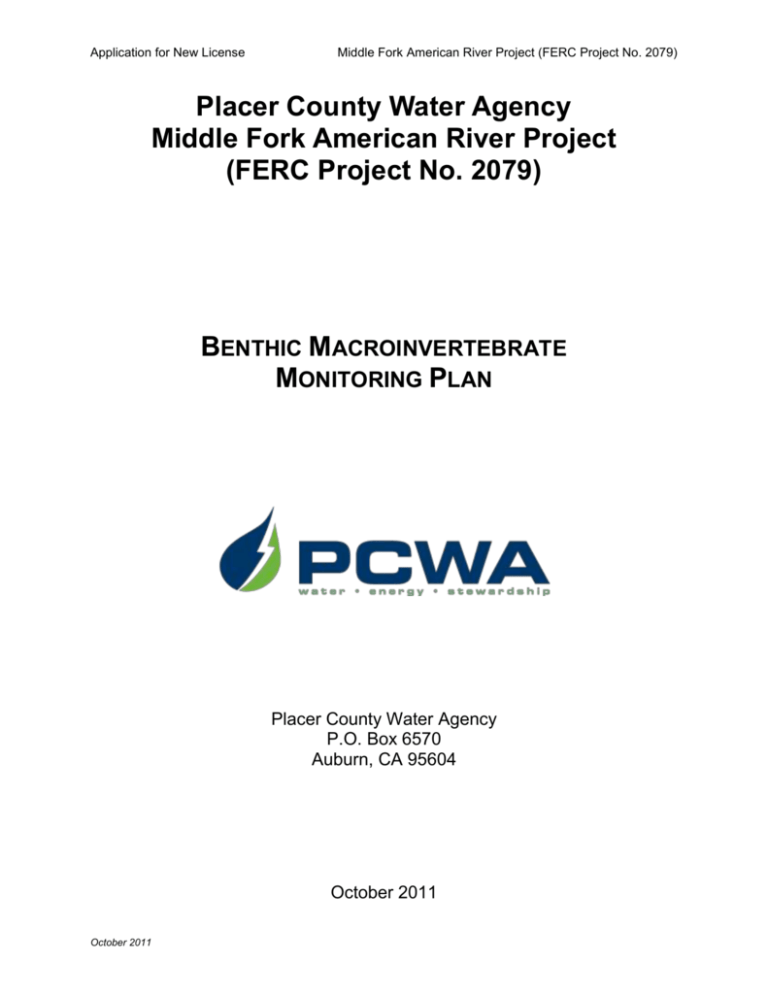
Application for New License Middle Fork American River Project (FERC Project No. 2079) Placer County Water Agency Middle Fork American River Project (FERC Project No. 2079) BENTHIC MACROINVERTEBRATE MONITORING PLAN Placer County Water Agency P.O. Box 6570 Auburn, CA 95604 October 2011 October 2011 Application for New License Middle Fork American River Project (FERC Project No. 2079) TABLE OF CONTENTS Page 1.0 2.0 3.0 4.0 Introduction ............................................................................................................. 1 BMIMP Organizaton ............................................................................................... 1 BMIMP Objective .................................................................................................... 1 Monitoring Approach............................................................................................... 1 4.1 Monitoring Locations and Schedule ................................................................ 2 4.2 Monitoring Methods ......................................................................................... 2 4.2.1 Benthic Macroinvertebrate Sampling .................................................... 2 4.2.2 Physical Conditions Characterization ................................................... 3 4.2.3 Benthic Macroinvertebrate Sampling Processing ................................. 3 4.3 Analysis Methods ............................................................................................ 3 4.3.1 Benthic Macroinvertebrate Metrics ....................................................... 3 4.4 Electronic Databases ...................................................................................... 4 5.0 Reporting and Consultation .................................................................................... 4 6.0 Literature Cited ....................................................................................................... 4 October 2011 i Application for New License Middle Fork American River Project (FERC Project No. 2079) List of Tables BMIMP Table 1. Benthic Macroinvertebrate Monitoring Locations. List of Maps BMIMP Map 1. Benthic Macroinvertebrate Monitoring Locations. List of Acronyms BMI BMIMP CDFG FERC MFP PCWA Project RWB SAFIT SD State Water Board SWAMP TRC TSR USDA-FS USGS October 2011 benthic macroinvertebrates Benthic Macroinvertebrate Monitoring Plan California Department of Fish and Game Federal Energy Regulatory Commission Middle Fork American River Project Placer County Water Agency Middle Fork American River Project reachwide benthos Southwest Association of Freshwater Invertebrate Taxonomists Supporting Document State Water Resources Control Board Surface Water Ambient Monitoring Program targeted riffle composite Technical Study Report United States Department of Agriculture-Forest Service United States Geological Survey ii Application for New License 1.0 Middle Fork American River Project (FERC Project No. 2079) INTRODUCTION This Benthic Macroinvertebrate Monitoring Plan (BMIMP) was developed for the Placer County Water Agency’s (PCWA) Middle Fork American River Project (MFP or Project) located on the west slope of the Sierra Nevada range primarily in Placer County, California. The goal of the BMIMP is to periodically characterize benthic macroinvertebrates (BMI) at select sites in the bypass and peaking reaches associated with the MFP over the term of the new license. This information will be presented in report form along with BMI data from previous monitoring years including historical BMI data collected during the MFP relicensing (AQ 3 – Macroinvertebrate and Aquatic Mollusk Technical Study Report – 2008 [AQ 3 – TSR]; Supporting Document [SD] B) (PCWA 2011a; SD B). If the Western pearlshell mussel (Margaritifera falcata) is designated a sensitive species, then specific monitoring shall be developed for them within this benthic macroinvertebrate plan. Known sites shall be monitored, and suitable habitat within each reach shall be surveyed for presence, in coordination with USFS, CDFG, and SWRCB. If any other benthic macroinvertebrates are designated a threatened, endangered, or sensitive species during the term of the license, then additional monitoring may be required. 2.0 BMIMP ORGANIZATON The BMIMP is organized into the following sections: Section 3.0 BMIMP Objective: This section defines the purpose of the BMIMP. Section 4.0 Monitoring Approach: This section describes the approach for monitoring of BMIs over the term of the new license, including monitoring locations and schedule, and sampling and analyses methods. Section 5.0 Reporting and Consultation: This section outlines reporting that will be required over the term of the new license and describes agency consultation that would be conducted following the completion of each monitoring period. Section 6.0 Literature Cited: This section provides a list of documents or other resources that are referenced in the BMIMP. 3.0 BMIMP OBJECTIVE The objective of the BMIMP is to monitor BMIs at select sites in the bypass and peaking reaches associated with the MFP over the term of the license. 4.0 MONITORING APPROACH This section describes the approach for BMI monitoring, including monitoring locations and schedule, sampling methods, and analytical methods. October 2011 1 Application for New License 4.1 Middle Fork American River Project (FERC Project No. 2079) MONITORING LOCATIONS AND SCHEDULE Benthic macroinvertebrate monitoring in the bypass and peaking reaches will be conducted at locations that were sampled in 2007 as part of relicensing studies completed for the MFP (AQ 3 – TSR) (PCWA 2011a; SD B). The specific macroinvertebrate monitoring locations are listed in BMIMP Table 1 and are depicted on BMIMP Map 1. Benthic macroinvertebrate monitoring will be conducted following license issuance at each of the monitoring sites in years 2, 3, 7, 8, 13, 14 and thereafter in years 4 and 5 of every subsequent ten-year period for the term of the license except for the last ten year period. Monitoring efforts in the last ten year period of the license will include data collection for two consecutive years immediately prior to the filing of a NOI to provide baseline information for the next relicensing process. 4.2 MONITORING METHODS The methods for the BMI field sampling, physical conditions characterization, and sample processing are described below. 4.2.1 Benthic Macroinvertebrate Sampling At the monitoring sites, benthic samples will be collected following the Surface Water Ambient Monitoring Program (SWAMP)1 (Ode 2007) protocols. The sampling will be conducted during the late summer/early fall base flow period of each monitoring period (BMIMP Table 1). SWAMP sampling methods and field data forms will be consistent with those used during the 2007 relicensing studies (AQ 3 – TSR) (PCWA 2011a; SD B). Sampling will be coordinated with the late summer/early fall fish population monitoring (PCWA 2011b). SWAMP includes two BMI sampling methods: (1) targeted riffle composite (TRC); and (2) reachwide benthos (RWB). The TRC sample consists of a composite of eight subsamples randomly selected from the riffle habitats within the study site. The RWB sampling does not target any specific type of mesohabitat. RWB samples collected from each sampling site are a composite of 11 sub-samples, each taken from one of 11 equally spaced transects. The transects are spaced 15 meters apart, or 25 meters if the wetted width of the channel is greater than 10 meters wide. Sub-sampling alternates between left-center, center, and right-center locations on each sequential transect. Physical habitat measurements (e.g., length, width, and depth of area sampled) at each of the transects. Water temperature and specific conductance will also be collected at the sampling sites. 1 The survey protocol will only be modified through mutual agreement between PCWA, CDFG, State Water Board, and USDA-FS. October 2011 2 Application for New License Middle Fork American River Project (FERC Project No. 2079) All quality assurance procedures for the field and the laboratory, as described in the SWAMP protocol, will be followed. A Chain-of-Custody Record form will be completed for the purpose of tracking macroinvertebrate samples from the field to the laboratory and then to their final storage/disposition. 4.2.2 Physical Conditions Characterization Routine observations will be made of habitat and physical conditions at the monitoring sites. These observations will include physical measurements of water temperature and specific conductance. Length, width, and depth of the area sampled will also be recorded. Mesohabitat type data consistent with those used during the 2007 relicensing studies (AQ 3 – TSR) (PCWA 2011a; SD B) will be collected at the monitoring sites. Photographs illustrating the site characteristics will be collected during the field sampling. 4.2.3 Benthic Macroinvertebrate Sampling Processing The SWAMP samples will be processed at a reputable laboratory. At the laboratory, the samples will be processed following the same protocols as those used for the 2007 study (PCWA 2011a)2. The BMI taxonomy will be processed to the Southwest Association of Freshwater Invertebrate Taxonomists (SAFIT) taxonomic level 2 (Richards and Rogers 2006). Generally this is a genus-species level of taxonomic identification. The samples will be processed following SWAMP protocols and the samples will be prepared following the methods recommended by the United States Geological Survey (USGS) (Cuffney et al. 1993) and described in Vinson and Hawkins (1996). 4.3 ANALYSIS METHODS 4.3.1 Benthic Macroinvertebrate Metrics Data will be provided for 300 and 500 organism count sub-samples, and will include species abundances and BMI metrics for each sampling site. A number of metrics can be calculated to describe the BMI community at a sampling site. The metrics that will be calculated for the BMI monitoring will be consistent with those calculated for the 2007 study (PCWA 2011a; SD B), and will include the hydropower metrics outlined in Rehn (2009). Additional information on each of these metrics is summarized in PCWA (2011a; SD B) and Rehn (2009)3. 2 The sampling processing methods will only be modified through mutual agreement between PCWA, CDFG, State Water Board, and USDA-FS. 3 If during the license term, an updated set of hydropower metrics is developed, its use may be required either in addition to or instead of the metrics described in Rehn (2009) if approved by CDFG, State Water Board, and USDA-FS. October 2011 3 Application for New License Middle Fork American River Project (FERC Project No. 2079) The results will be presented along with those from previous sampling periods and compared between monitoring sites together with a discussion of any changes observed from previous data sets or inconsistencies from the metrics. 4.4 ELECTRONIC DATABASES All macroinvertebrate sampling data (date, locations, species, abundance, etc.) will be entered and stored in electronic databases (Excel spreadsheet or similar). The databases will be provided to resources agencies upon request. Copies of the SWAMP datasheets will also be provided to resource agencies upon request. 5.0 REPORTING AND CONSULTATION A Benthic Macroinvertebrate Monitoring Report will be prepared by PCWA and distributed to the United States Department of Agriculture – Forest Service (USDA-FS), State Water Resources Control Board (State Water Board), and California Department of Fish and Game (CDFG) for review and comment within 120 days following the completion of each monitoring year. The reports, where appropriate, will follow the general presentation layout for BMI sampling data provided in the AQ 3 – TSR (PCWA 2011a; SD B). A 60-day review period will be provided to the agencies. Based on the results of the monitoring and/or comments received during the review process, PCWA and the agencies may call a meeting to discuss the results or modify the monitoring program. Within 60 days of receipt of comments, or 60 days following any meeting, comments will be addressed and the final report will be filed by PCWA with the agencies (USDA-FS, State Water Board, and CDFG) and the Federal Energy Regulatory Commission (FERC). 6.0 LITERATURE CITED Cuffney, T.F., Gurtz, M.E. and Meador, M.R. 1993. Methods for collecting benthic invertebrate samples as part of the National Water-Quality Assessment Program. United States Geological Survey Open-File Report 93-406 and Moulton, S.R. II, J.L. Carter, S.A. Grotheer, T.F. Cuffney and T.M. Short. 2000. Methods of analysis by the U.S. Geological Survey National Water Quality Laboratory processing, taxonomy, and quality control of benthic macroinvertebrate samples. United States Geological Survey Open-File Report 00-212 Ode, P.R. 2007. Standard operating procedures for collecting macroinvertebrate samples and associated physical and chemical data for ambient bioassessments in California. California State Water Resources Control Board Surface Water Ambient Monitoring Program (SWAMP) Bioassessment SOP 001. Placer County Water Agency (PCWA). 2011a. AQ 3 – Macroinvertebrate and Aquatic Mollusk Technical Study Report - 2007. Available in PCWA’s Application for New License – Supporting Document B. ____. 2011b. Fish Population Monitoring Plan. Available in PCWA’s Application for New License – Supporting Document A. October 2011 4 Application for New License Middle Fork American River Project (FERC Project No. 2079) Rehn, A.C. 2009. Benthic macroinvertebrates as indicators of biological condition below hydropower dams on west slope Sierra Nevada streams, California, USA. River Research and Applications. 25(2):208-228.. Richards, A. B. and D. C. Rogers. 2006. List of Freshwater Macroinvertebrate Taxa from California and Adjacent States including Standard Taxonomic Effort Levels. Southwest Association of Freshwater Invertebrate Taxonomists (SAFIT). 215 pp. Vinson, M.R. and C.P. Hawkins 1996. Effects of sampling area and subsampling procedure on comparisons of taxa richness among streams. The Journal of the North American Benthological Society. 15:393-400. October 2011 5 Application for New License Middle Fork American River Project (FERC Project No. 2079) TABLES February 2011 Application for New License Middle Fork American River Project (FERC Project No. 2079) MAPS February 2011
